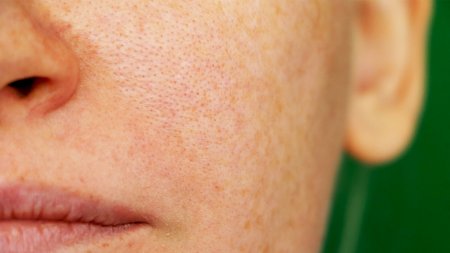All you need to know about oily skin: symptoms, causes, treatments
Do you suffer from oily skin? Discover our expert advice on mattifying your skin, tightening your pores and preventing imperfections.

Do you suffer from oily skin? Discover our expert advice on mattifying your skin, tightening your pores and preventing imperfections.
Oily skin is considered a physiological skin type, characterized by a thicker skin texture, dilated pores and a dull, oily, shiny appearance. Discover our expert advice on how to prevent imperfections on your skin.
Oily skin is characterized by a thick, granular texture, dilated, visible pores and a shiny appearance on the face or scalp. The presence of comedones (blackheads and whiteheads) is also characteristic of oily skin.

Sebum is the main cause of oily skin. Produced by the sebaceous glands, sebum plays a major role in the epidermis, providing suppleness, softness and balance. In the case of oily skin, we observe an overproduction of sebum, also known as hyperseborrhea, favoring the appearance of skin imperfections and giving an oily, shiny appearance to the face and scalp.

Internal causes
Hyperseborrhea is generally caused by hormonal factors that are triggered at puberty. Under the influence of hormones, the skin begins to produce more sebum, responsible for clogged pores.
Hereditary and genetic factors are also involved in the appearance of oily skin.

External causes
Other factors such as stress, pollution, smoking, alcohol and climate change seem to have a strong influence on the skin's balance and encourage a peak in seborrhea.
In fact, one degree rise in temperature increases sebum production by 10%.
Diet is also one of the causes of oily skin, since the sebaceous glands use certain nutrients such as glucose and fatty acids to produce sebum. For this reason, a diet with a low glycemic index will help limit sebum production.
Finally, the use of cosmetics that are too harsh on the skin can also have an impact on oily skin.
Oily skin affects both girls and boys, and can last well into adulthood.
Sebum production begins earlier in girls, due to earlier puberty, so they are more prone to oily skin during adolescence.
Men, on the other hand, naturally produce more sebum than women in adulthood, and are therefore very frequently confronted with oily skin problems after adolescence.
The areas richest in sebum and therefore particularly affected by oily skin are :
If your skin is constantly shiny, your pores are visible and your complexion lacks radiance, your skin needs to be purified. By adopting a natural, purifying and mattifying skin care routine, you allow your skin to breathe and regain a better balance.
The purpose of cleansing is to purify the skin and reduce excess sebum.
Oily skin has specific needs; to cleanse your skin, opt for gentle, non-comedogenic products.
Prefer cleansing gel and micellar water, and adopt a morning and evening cleansing routine to remove dirt, pollutant particles and any other residues that may settle after the night or during the day.
Beware of overly aggressive or stripping products, which will cause the skin to react by producing more sebum.
Just because your skin is oily doesn't mean it doesn't need moisturizing.
In the morning, after cleansing, apply a light, non-greasy, mattifying day cream to reduce excess sebum, moisturize and protect your skin.
In the evening, choose an emulsion or night cream specifically for oily skin, to be applied after removing make-up.
Exfoliation allows you to purify your skin in depth and give it a radiant glow.
Gentle scrubs or absorbent, cleansing masks help to unclog pores by removing excess sebum, dead skin cells and impurities.
Exfoliation can be carried out once or twice a week at most, always using non-aggressive products.
Over-stimulating the epidermis by exfoliating the skin more than once a week is a mistake that could lead to the overproduction of sebum.
Oily skin mainly affects teenagers, who are more prone to overproduction of sebum during puberty.
Combination skin, as its name suggests, is neither completely dry nor completely oily. It is unbalanced, and faces a problem of sebum quality and quantity.
Combination skin is particularly prone to imperfections on the middle part of the face, known as the T-zone.
When we have oily skin, we tend to want to use stripping and drying products to get rid of that shiny layer that covers our skin, but we often make mistakes.
Oily skin requires regular care and a moisturizing routine using gentle, delicate products.
Here are the mistakes to avoid when you have oily skin:
As mentioned above, certain external factors favor the appearance of oily skin. By following the advice below, you can prevent the appearance of oily skin:
Before applying make-up to your skin, always cleanse first, then moisturize. These two steps prepare your skin and provide a base for make-up application and improved hold.
For oily skin, always use non-comedogenic products and opt for light, non-greasy textures with a matte finish. For a healthy-glow effect, choose a tinted emulsion foundation, or a fluid foundation to correct imperfections.
Discover the Sébium BIODERMA range of facial cleansers specially designed for oily skin:
H2O Micellar Water: purifies and cleanses the skin, removing impurities and make-up.
Foaming Gel: gentle, purifying cleanser that visibly reduces excessive shine.
Discover the Sébium BIODERMA range of facial cleansers specially designed for oily skin:
H2O Micellar Water: purifies and cleanses the skin, removing impurities and make-up.
Foaming Gel: gentle, purifying cleanser that visibly reduces excessive shine.
BIODERMA offers sun care products for oily skin that let the skin breathe:
Cover Touch SPF 50+ in light or golden hues: mineral sun care that respects oily skin by controlling sebum for 8 hours.